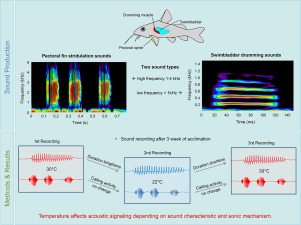当前位置:
X-MOL 学术
›
Comp. Biochem. Physiol. A Mol. Integr. Physiol.
›
论文详情
Our official English website, www.x-mol.net, welcomes your feedback! (Note: you will need to create a separate account there.)
Temperature affects sound production in fish with two sets of sonic organs: The Pictus cat.
Comparative Biochemistry and Physiology A: Molecular & Integrative Physiology ( IF 2.3 ) Pub Date : 2019-10-22 , DOI: 10.1016/j.cbpa.2019.110589 Friedrich Ladich 1 , Isabelle Pia Maiditsch 1
Comparative Biochemistry and Physiology A: Molecular & Integrative Physiology ( IF 2.3 ) Pub Date : 2019-10-22 , DOI: 10.1016/j.cbpa.2019.110589 Friedrich Ladich 1 , Isabelle Pia Maiditsch 1
Affiliation

|
Sound communication is affected by ambient temperature in ectothermic animals including fishes. The present study examines the effects of temperature on acoustic signaling in a fish species possessing two different sound-generating mechanisms. The Amazonian Pictus catfish Pimelodus pictus produces low-frequency harmonic sounds (swimbladder drumming muscles) and high-frequency stridulation sounds (rubbing pectoral fin spines in the pectoral girdle). Sounds of 15 juveniles were recorded when hand-held after three weeks of acclimation at 30 °C, 22 °C and again 30 °C. The following sound characteristics were investigated: calling activity, sound duration, fundamental frequency of drumming sounds and dominant frequency of stridulation sounds. The number of both sound types produced within the first minute of experiments did not change with temperature. In contrast, sound duration was significantly shorter at 30 °C than at 22 °C (drumming: 78-560 ms; stridulation: 23-96 ms). The fundamental frequency of drumming sounds and thus the drumming muscle contraction rate varied from 127 Hz to 242 Hz and increased with temperature. The dominant frequency of broadband stridulation sounds ranged from 1.67 kHz to 3.39 kHz and was unaffected by temperature changes. Our data demonstrate that temperature affects acoustic signaling in P. pictus, although the changes differed between sound characteristics and sound type. The effects vary from no change in calling activity and dominant frequency, to an increase in fundamental frequency and shortened duration of both sound types. Together with the known effects of temperature on hearing in the Pictus cat, the present results indicate that global warming may affect acoustic communication in fishes.
中文翻译:

温度会影响具有两组声音器官的鱼类的声音产生:Pictus cat。
声音交流受包括鱼类在内的等温动物的环境温度影响。本研究检查了温度对具有两种不同发声机制的鱼类的声信号的影响。亚马逊鲶鱼 Pimelodus pictus 产生低频谐波声音(游泳的鼓声肌肉)和高频颤音(摩擦胸带中的胸鳍棘)。在 30°C、22°C 和 30°C 环境适应三周后,记录了 15 名青少年手持时的声音。研究了以下声音特征:呼叫活动,声音持续时间,鼓声的基频和颤音的主要频率。在实验的第一分钟内产生的两种声音类型的数量不随温度变化。相比之下,30 °C 时的声音持续时间明显短于 22 °C 时(击鼓:78-560 毫秒;颤音:23-96 毫秒)。击鼓声音的基频以及击鼓肌肉收缩率从 127 Hz 到 242 Hz 不等,并随温度升高而增加。宽频响声的主频范围为 1.67 kHz 至 3.39 kHz,不受温度变化的影响。我们的数据表明,温度会影响 P. pictus 的声学信号,尽管声音特征和声音类型之间的变化不同。效果从呼叫活动和主频率没有变化,到基频增加和两种声音类型的持续时间缩短。连同已知的温度对 Pictus 猫听力的影响,
更新日期:2019-10-22
中文翻译:

温度会影响具有两组声音器官的鱼类的声音产生:Pictus cat。
声音交流受包括鱼类在内的等温动物的环境温度影响。本研究检查了温度对具有两种不同发声机制的鱼类的声信号的影响。亚马逊鲶鱼 Pimelodus pictus 产生低频谐波声音(游泳的鼓声肌肉)和高频颤音(摩擦胸带中的胸鳍棘)。在 30°C、22°C 和 30°C 环境适应三周后,记录了 15 名青少年手持时的声音。研究了以下声音特征:呼叫活动,声音持续时间,鼓声的基频和颤音的主要频率。在实验的第一分钟内产生的两种声音类型的数量不随温度变化。相比之下,30 °C 时的声音持续时间明显短于 22 °C 时(击鼓:78-560 毫秒;颤音:23-96 毫秒)。击鼓声音的基频以及击鼓肌肉收缩率从 127 Hz 到 242 Hz 不等,并随温度升高而增加。宽频响声的主频范围为 1.67 kHz 至 3.39 kHz,不受温度变化的影响。我们的数据表明,温度会影响 P. pictus 的声学信号,尽管声音特征和声音类型之间的变化不同。效果从呼叫活动和主频率没有变化,到基频增加和两种声音类型的持续时间缩短。连同已知的温度对 Pictus 猫听力的影响,



























 京公网安备 11010802027423号
京公网安备 11010802027423号